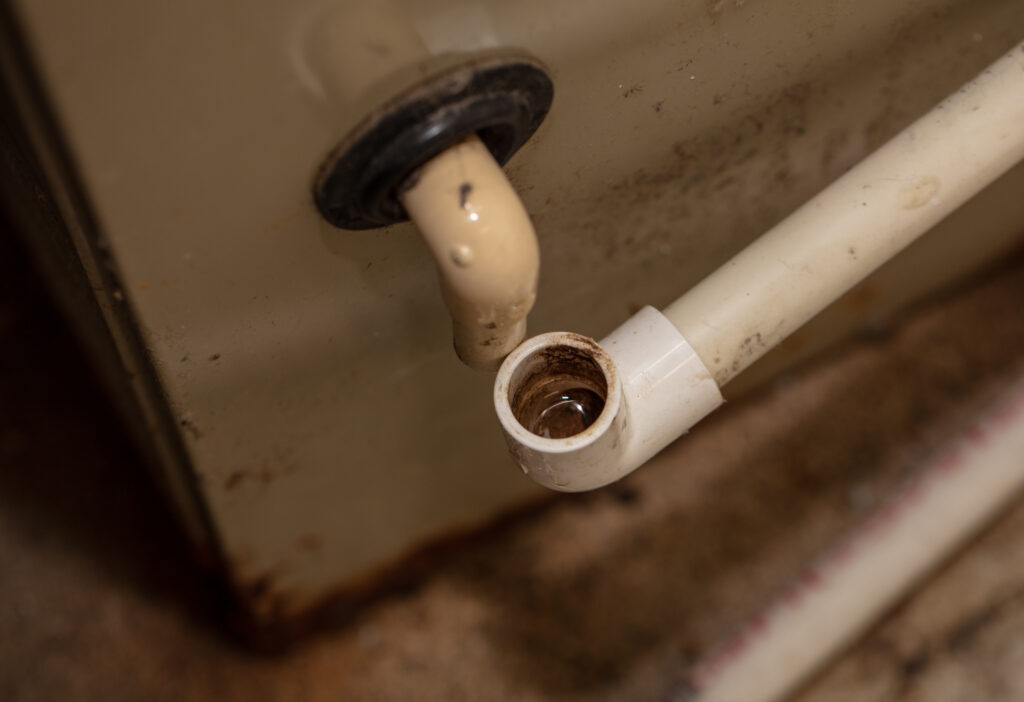How to Clean a Clogged AC Drain Line

Homeowners often focus on the air conditioner unit itself and how well it’s running while overlooking the drain line, a crucial component of the AC unit. If the air conditioner line inside the house gets clogged, it can cause water damage and mold growth.
This not only poses a risk to your house and family members but can also cause your AC unit to malfunction. The good news is that a clogged AC drain line is an easy fix you can attempt yourself or hire an HVAC professional to handle.
This guide will discuss how to prevent AC malfunctions and water damage and provide a step-by-step guide on fixing a clogged AC drain line.
Table of Contents
What is an AC Drain Line?
The AC drain line is responsible for draining the AC’s condensation from the air inside your home to the outdoor handler. Removing the condensation keeps the air cool and dry.
You can usually see the end of the drain line by your AC unit outside. It allows water to drip when the AC is running. Keeping the drain line clean and unclogged is important to ensure good air quality and reduce the risk of water damage.
Understanding AC Drain Line Clogs
The most important thing to consider when dealing with an AC drain line is why it clogs so you can prevent it from happening.
The key is to keep your drain line clean and free from debris. This can happen even with normal use of your AC; it’s nothing you’ve done wrong.
As the air circulates, dust, debris, dirt, and other harmful particles get trapped in the drain. If it blocks enough, it can cause a blockage and put your house at risk for water damage and mold growth.
Regularly cleaning the drain line ensures there are no clogs and the system can properly drain, keeping your home cool and free from mold or mildew growth.
If you aren’t comfortable cleaning your system, regular AC inspections and repairs by a professional can prevent this from happening to your system. However, even with regular inspections, you should understand the signs of a clogged drain line.
Signs of a Clogged AC Drain Line
Understanding the common signs of a clogged AC drain line can help you catch the problem early before it causes further damage.
Here are some common signs.
- Full drain pan: If the AC line gets clogged, the drain pan will likely fill up with water that can get moldy. As the AC runs, it will recirculate moldy water throughout your home. Check your drain pan often to ensure this isn’t happening.
- Musty odors: If the clogged AC drain line has mold or other debris, the air in your home may smell musty. You may also smell it when you stand near the AC unit, indoors or out. Pay close attention when the AC runs to see if this is an issue.
- Water under the evaporator coil unit: If you notice a pool of water under the evaporator coil unit inside, it could be a sign that the drain pan is full due to a clogged line. The pan can only hold so much water and will eventually spill over onto the floor. Monitoring your AC unit often will let you know if this is happening.
- AC won’t turn on: If you have a newer AC unit, it may have an automatic shut-off that prevents the unit from running if the drain pan is full. This safety feature prevents water damage and mold growth by not allowing the AC to run. If your AC struggles to run, this could be the reason.
Tools and Materials Needed
To clean your AC drain line, you need a few simple tools and materials you may already have lying around the house.
- Wet-dry vacuum
- Clean rags
- Garden hose
- Plumber’s snake
- PVC pipe cleaner (usually distilled vinegar)
If you unclog the drain yourself, consider wearing protective gloves and eye protection. If you suspect mold growth in the line, consider an N-95 mask or respirator to avoid breathing in harmful toxins. If you aren’t sure if there is mold growth, consider erring on the side of caution.
Step-by-Step Guide to Cleaning a Clogged AC Drain Line
Most AC drain line clogs are simple enough to clean yourself, especially if you catch them, early. Here are the simple steps to consider when cleaning your drain line before calling an HVAC professional.
Turn off the AC Unit
Even if your AC unit isn’t running, turning off the power is a good idea. Since you’re dealing with water and potential electricity, you want to reduce the risk of any issues. This also eliminates the risk of further water damage by not letting the system run while you clear the debris.
Check the Drain Pan
Next, check the drain pan. If water is in it, soak it up with the clean rags or the wet-dry vac. You should also thoroughly clean the pan to prevent mold growth from any leftover water. This is an easy way to determine if you have a drain line clog, so check the drain pan often.
Locate AC Drain Line
After cleaning the drain pan, it’s time to clean the drain line. You must find an access point to the debris buildup. This can usually be found by the indoor unit. On some models, it’s a T-shaped fitting, and there is usually a cap on it.
Remove Debris and Build Up
Once you have access to the drain line, determine if there is any debris you can easily remove with a rag or the wet-dry vac. If the clog is deep within the line, you may need a plumber’s snake. You’ll know you’re doing it right when you see the evidence of the clog (i.e., a dark mass) that comes out of the drain line.
Flush the Drain Line with Water
To determine if you’ve successfully cleared the line, flush it with water. You can do this using a garden hose. Watch at the end of the drain line to see if the water flows freely from the line or only dribbles. If it runs freely, you can proceed to the next step.
Repeat the above steps if you still suspect a clog because the water doesn’t run freely. However, if the clog is bad enough and these steps didn’t work, it’s best to call an HVAC professional to handle it for you.
Vinegar or Bleach for Deep Cleaning
Removing the clog is one part of the process. Next, you need to deep clean it to eliminate mold or other buildup. Always ask your HVAC professional what is safe for your AC drain line. Typically, distilled vinegar is safe but always ask first.
Resassemble and Test the Unit
After clearing the clogged AC drain line, you must reassemble it and test the system. Be sure all fittings are properly adjusted, and the system runs well when you turn it on again.
Tips for Preventing Future Clogs
After clearing an AC drain line, you’ll want to do whatever it takes to prevent a clogged line again. Here are some simple tips.
Maintenance Schedule
Stick to a strict AC maintenance schedule to prevent future clogs. This includes an annual HVAC inspection by a licensed professional and regular drain line cleaning. Depending on how often you use your AC, you should consider cleaning/flushing the line monthly.
Installing a Drain Line Cleaning Device
If you don’t want to be bothered with another monthly task, consider installing a drain line cleaning device. These smart devices automatically clean your drain line, helping you prevent unnecessary clogs. Always talk to your HVAC professional before installing one, though, to ensure it’s safe for your system.
Monitor for Signs of Clogs or Leaks
Instead of letting a clog worsen until you have your HVAC inspected, be aware of the signs of a clog and react quickly. For example, if you notice musty smells or a full drain pan, immediately clean the drain line to remove the clog before it worsens and causes more problems with your HVAC system.
Troubleshooting Common Issues
The easiest way to prevent common issues is to check the drain line every time you change the AC filter (usually every 30 days). If you notice excess water in the drain pan or the AC is having trouble running, check the line first.
If you continue having problems even after a DIY drain line cleaning, consider calling a professional to address the issue. There may be a larger problem than you can handle. The key is not to let a clog go unattended, as it could cause more problems with other parts of your AC unit.
Conclusion
A clogged AC drain line is a common AC problem that can be easily fixed. The key is regular maintenance, which you can do yourself if you can locate the air conditioner line inside the house.
Not taking care of debris in your AC drain line can lead to clogs, inefficient AC operation, and potential water damage in your house. Don’t take a chance. If you aren’t comfortable maintaining your AC system yourself or think you have a large clog, contact an HVAC professional near you to handle the problem and get your AC working efficiently again.
FAQs
Where is my AC drain line?
The AC drain line runs from the indoor unit to the outdoor part. You can access it by the indoor unit and check the drain pan in the same location.
How can you clear out an AC drain line?
The easiest way to unclog an AC drain line is to run a wet-dry vac through it to pull the debris out. If that doesn’t work and you are comfortable working with a plumber’s snake, you can try fishing the debris out of it. If not, contact an HVAC professional to avoid further damage to your system.
Should the AC drain line be dripping?
It’s normal for an AC drain line to drip a little, but only while the system runs. If you notice excessive dripping or the drain pan is full, it’s a sign that you have a clogged AC drain line.
Why is so much water coming from my AC drain line?
The most common reason for excessive water coming from your AC drain line is a clogged line. If the water cannot properly drain, it may dump water from places it shouldn’t be releasing.
Check Out Additional HVAC Resources
- Guide to HVAC Hard Start Kits
- Guide to Furnace Installation
- Ductless Mini Splits vs Central AC
- MERV 8 vs Merv 11 vs Merv 13: Which is Best?
- What is Auxiliary Heat?
Sources

Anna has over six years of experience in the home services and journalism industries and serves as the Content Manager at MyHomePros.com, specializing in making complex home improvement topics like HVAC, roofing, and plumbing accessible to all. With a bachelor’s degree in journalism from Auburn University, she excels in crafting localized, comprehensive guides that cater to homeowners’ unique needs. Living on both coasts of the United States has equipped her with a distinctive perspective, fueling her passion for turning any house into a cherished home through informed, personalized decision-making.








